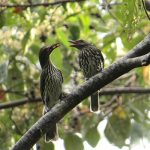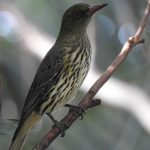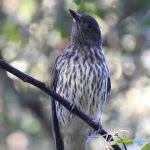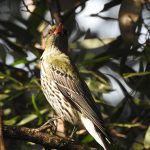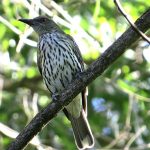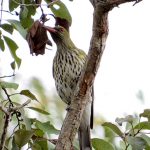OLIVE-BACKED ORIOLE
The Olive-backed Oriole is a striking bird that graces the Australian landscape with its melodious calls and vibrant plumage. This bird is a medium-sized member of the Oriole family and is known for its beautiful olive-green back, from which it gets its name. Its head and throat are a bright yellow, with a black line extending from the base of the bill through the eyes and to the sides of its neck, creating a mask-like effect. The underparts of the bird are yellow with a white belly, and the wings have a black and yellow pattern that is especially visible during flight.
In terms of habitat, the Olive-backed Oriole can be found across eastern and northern Australia. Its range extends from the Kimberley region in Western Australia, through the Northern Territory, across Queensland, New South Wales, Victoria, and into South Australia. This bird is quite adaptable and can be found in a variety of environments including woodlands, forests, mangroves, and even well-vegetated urban areas.
One of the most interesting facts about the Olive-backed Oriole is its vocal abilities. The species is known for its rich, fluty song that can vary greatly between individuals. Their calls are often heard during the spring and summer months, which is their breeding season. They have a remarkable ability to mimic the calls of other birds and even some man-made sounds, which adds to the complexity and beauty of their own natural song.
When it comes to nesting, these orioles are quite resourceful. They construct their nests out of grass and twigs, which are carefully woven together to create a deep cup-like structure. These nests are usually suspended from a branch in a tree. The female will lay two to three eggs, which are incubated for about two weeks before the chicks hatch.
The Olive-backed Oriole’s diet consists mainly of insects, fruits, and berries. They play an important role in the ecosystem as both predator and seed disperser, contributing to the control of insect populations and the propagation of various plant species.
Conservation-wise, the Olive-backed Oriole is currently not considered to be under threat. However, like many species, it is affected by habitat loss and fragmentation. Maintaining healthy ecosystems and preserving natural habitats are crucial to ensuring the Olive-backed Oriole, along with countless other species, continues to thrive.
The Olive-backed Oriole is a beautiful and melodious part of Australia’s birdlife. It is a delight to birdwatchers and a vital component of the ecosystems it inhabits. Through understanding and appreciating birds like the Olive-backed Oriole, we can foster a greater desire to protect the natural environments that sustain them.

